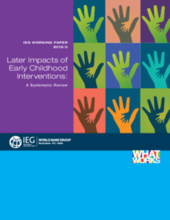This paper discusses how the economic rationale for investing in young children goes beyond improving quality of life during early childhood; it hinges on the belief that the benefits of these investments persist into school age and beyond. This report is the first systematic review devoted exclusively to investigating this theory.
By identifying and analyzing all 55 studies that provide reliable causal estimates, the report provides the most complete, credible evidence to date on the post-early childhood effects of early childhood interventions. It serves three important functions. First, it provides analysis on early childhood interventions whose sustained effects have been evaluated across six areas of human development. Second, it examines how effects change—both within a population (yielding shared prosperity implications) and over time. Finally, the review aims to improve the quality and coverage of ECD knowledge by enumerating commonly observed evaluation challenges and identifying research gaps on the question of benefits beyond early childhood.
Four important findings emerge from this effort:
- Early childhood interventions can, but do not always, lead to benefits later in life in the areas of cognition, language, socioemotional health, education, and the labor market. Evaluated interventions have not demonstrated consistent lasting advantages for physical development, although these outcomes are less salient to adult welfare.
- Gender-neutrality dominates outcomes generally, but schooling does tend to improve for girls, the poor, and those who are in quality preschool and supplemental feeding programs for longer.
- Nutrition interventions may need to be in place throughout and beyond the first 1,000 days to leverage the window of opportunity from conception to age 2 and achieve sustained effects beyond early childhood.
- Sizeable knowledge gaps persist but can be closed with careful planning and design.
Early childhood development holds considerable promise for making progress on the World Bank’s dual objectives of reducing poverty and increasing shared prosperity while encouraging economic growth. More investment and evaluation are required to enable interventions, and the children they serve, to realize their potential.

